You may not find this terribly rewarding unless you're included here, so this is a good time for casual and random browsers to turn back before they get too caught up in the sweep and majesty of the proceedings and can't let go.

A few physiological inconveniences taking a break, we've decided to walk out, in a stately manner, to visit the Thornrose Cemetery once again. (23 March 2025)

Along W Beverley St heading westward out of town

That's the back of our street, Frederick St, which runs parallel to Beverley just up the hill.


Almost there -- it's only a mile out from home.

Here we are. We first visited the Thornrose Cemetery shortly after we arrived in the USA, and in Staunton, six years ago, and, relying on its informative website we passed along some interesting background about the place at that time, which need not be repeated here.
More well-presented information is also available at https://visitstaunton.com/visit-staunton-on-foot-thornrose-cemetery/.

Suffice it to say that the originally 12-acre site on the hill here was set aside when the churchyards down town were filling up, and it welcomed its first permanent guest in 1853.

With time, the impressive gateway and some of the other similar structures were designed by T J Collins, the fairly amazing architect who created or rehabilitated some 200 buildings hereabouts from 1891 to 1911 (when his sons took over), buildings which basically put Historic Staunton on the map for the inspired variety of his designs.

Family second homes
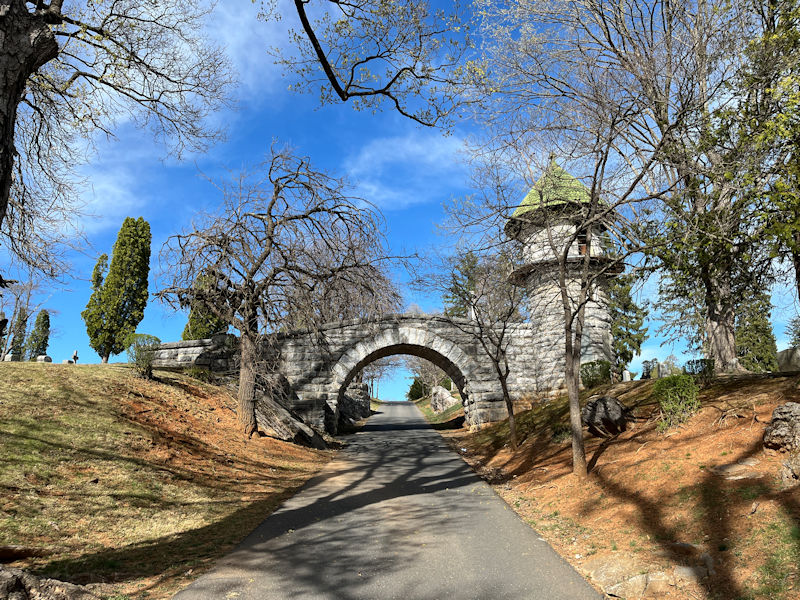
The limestone bridge, another Collins invention, with a ghostly white figure standing on it (barely visible here just left of the tower) that on closer inspection is either a woman or (dare we say it) an angel.
Either way, she's named 'Perpetual Care'.

The headstones, often in family groupings, are spread all over the hillside, but there's plenty of room left for the rest of us, as needed.


Here we are at 'Fort Stonewall Jackson' at the top of the hill, a Confederate Civil War Memorial commissioned in 1888.

It's said to have nearly 1,800 Confederate soldiers in residence, many named and as many unidentified, many of whom died in the course of Stonewall Jackson's brilliant defense of the Shenandoah Valley in 1862.


It's all very sad, of course . . . despite all of the inspiringly brave sentiments inscribed all round the plinth. So, especially in the absence of any mention of memorials for the Union casualties, we'll leave it there.

Back home, and then . . .

. . . friend Kim Schmutzler is visiting for only a day or two and is leading us southward to a hikeable venue that she discovered whilst catsitting for us during our Italian sojourn last fall.
We think of the countryside round here as fairly narrowly focused, ideologically speaking, and mostly in the wrong direction, but not always so -- they can still shine through from time to time.

So we're welcome to Boxerwood ('Boxerwood Nature Center & Woodland Garden') just south of Lexington, VA, half an hour south of Staunton, give or take.

Information plaques strewn about, and some very strange things to see here.

Like this! This (we read) is a Persian Ironwood [Parrotia persica], native to the Alborz mountains of northern Iran, planted here in 1958.
['Although we are far from its native range, we believe that a diverse collection of trees is beneficial, particularly in the face of dwindling global biodiversity and climate change.']


There's no one else about, apparently. At the welcome shed, a potential $5 donation was mentioned, and we have acknowledged that.

So this is where they keep the 'Spare Ribs'.

Amongst this sprawling expanse of paths and odd things, we're now passing the 'Pollinator Garden'.
We probably should have read that info plaque more carefully.

A testimony to Impatience? Not at all, nobody's in a hurry here.

Moving right along: the Fairy Forest, or . . .

. . . a pleasant Grimms' Tale suggestion of a fairy tale habitation, presently with second thoughts.

This seems to have something to do with bees, or . . . what? Hard to tell -- it's still technically the off-season.

An emerging swamp, with boardwalks conveniently spread all about. The terrain here is . . .

. . . bursting with these freaky little emergences pumping up out of the undersoil.

Whatever they are, we have agreed never to step off these bouncy little walkways through the wilds.

And especially nowhere near that!

Or that! So the walkways are much appreciated.

An arboreal casualty

We follow the path wherever it might take us.
Though we have noted that there are a few earnest but casual golfers up on the ridge above us. It's the back end of the Lexington Golf & Country Club, we later found. Not just random golfers!

Our journey continues . . .

. . . out onto a pleasant meadowish place, with . . .

. . . an oversized chair. Awaiting a purpose, no doubt.

We've just come upon a small sort of dock over a small sort of pond, and . . .
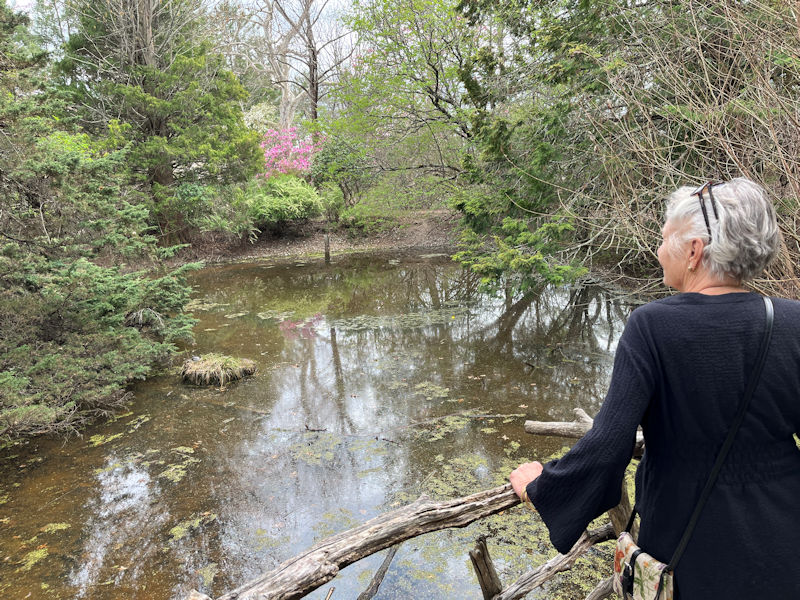
. . . Kristin has espied a small bit of Wildlife.

A frog, in fact. Great! Our day is made!

Head's up . . . he (or she) knows we're here. We won't trouble her (or him) any further.
Who doesn't love a frog?
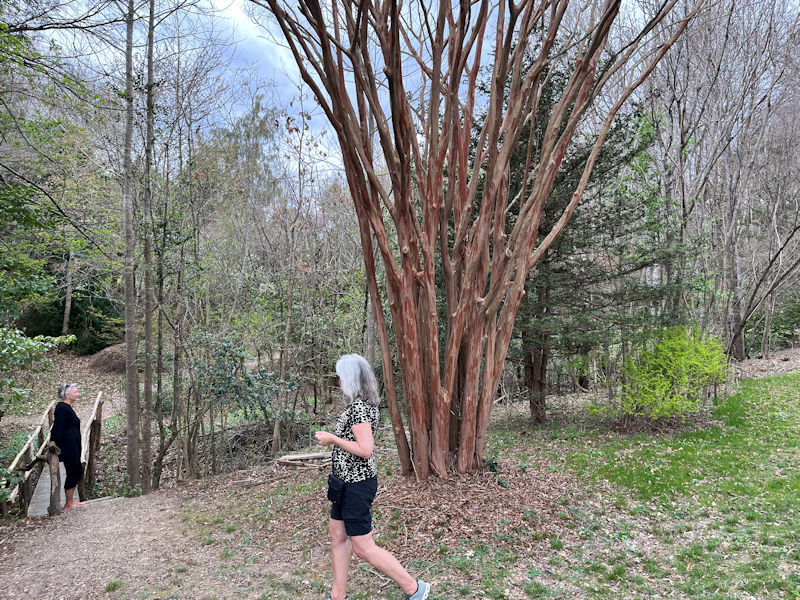
Kristin and Kim, down to another bridge, passing a watcha-may-call-it.

Amongst a sobering collection of watcha-may-call-its

But about those freaky little emergences again, we asked a young woman who was working at something along our walk, and she ventured that they are probably new root systems or something, 'emerging'.

Good luck to them, too. Global diversity. Climate change. Who would not applaud these admirable long-range purposes?
We all have to do our part.

A brief debriefing -- 'so what have we learnt today?'
{-- 'Well, stay on the little walkways?'}

Back past the Spare Ribs

Dare we suggest it, but this is a pretty strange place -- but obviously with the best of intentions and a fair amount of light-hearted fun-stuff. Perhaps they are hoping to progress this project further as time goes on.

Downtown Lexington. See more here, including the famous Red Hen where White House press secretary Huckabee's party was refused a lunch in 2018.
A feline interlude

Melvin believes, correctly, that it's time for some telly, and he waits patiently. As usual.

Tonight it's a documentary series about tectonic plates, and this episode's focus is on South America.

Clever graphics, especially about 'continental subduction', are more than a little past Melvin's capacities so far.
BTW, that clock is not working at the moment. It's built onto a map of Lake Minocqua, Wisconsin.

But people walking round, explaining things earnestly, can hold his interest, especially with the subtitles on, but . . .

. . . that doesn't really last too long in the end.

Choupette's interests run in a different direction, namely . . .

. . . being statuesque.
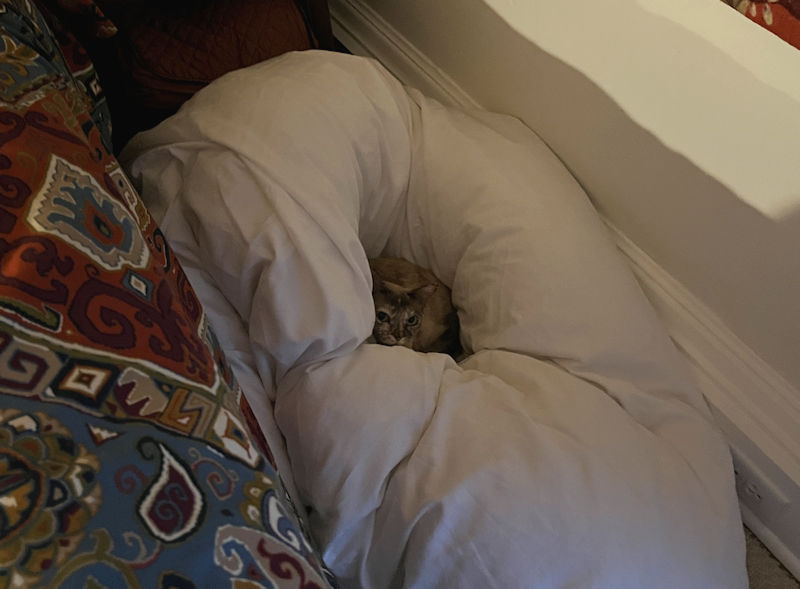
Or just hiding out.
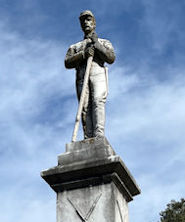 Dwight Peck's personal website
Dwight Peck's personal website

























































